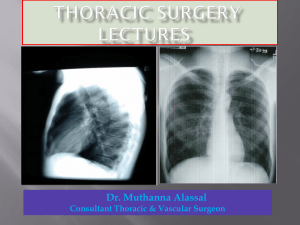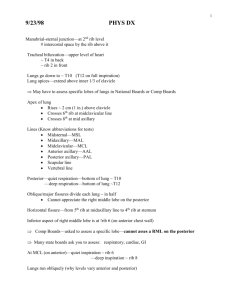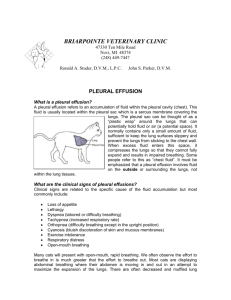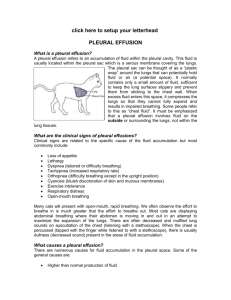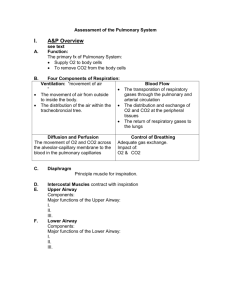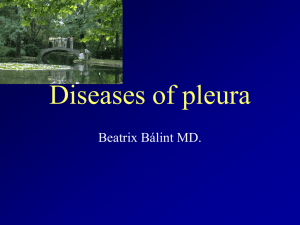Inspection of the thorax
advertisement
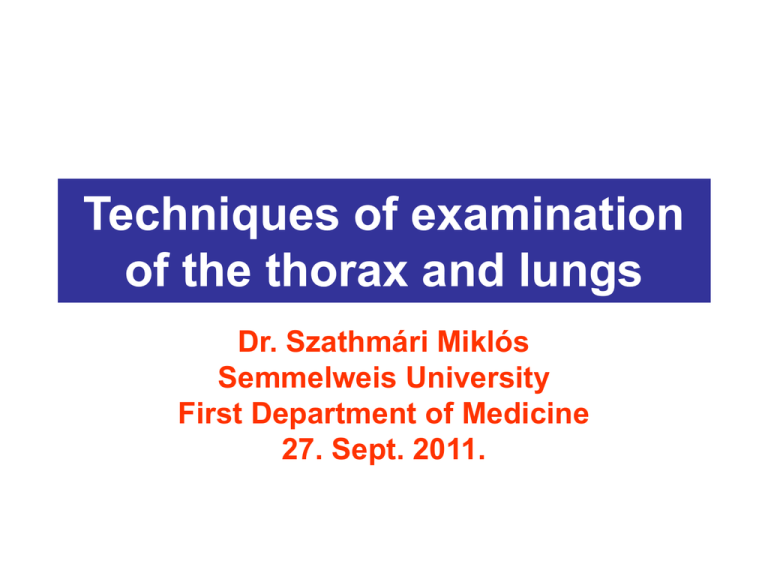
Techniques of examination of the thorax and lungs Dr. Szathmári Miklós Semmelweis University First Department of Medicine 27. Sept. 2011. Inspection of the thorax • Observe: – the shape of chest • Deformities – the respiratory movement • Importance: – The deformities influence • The percussion sounds • The breathing and the circulation • The diagnostic importance of asymetry – The decrease of the respiratory movement is the most important sign of the disease of chest/lung Inspection of the thorax • Shape of the chest – Normal adult thorax: is wider than it is deep. – Barrel chest: increased anteriorposterior diameter. – Funnel chest: depression in the lower portion of the sternum. – Pigeon chest: the sternum is displaced anteriorly, increasing the AP diameter. – Thoracic kyphoscoliosis: abnormal spinal curvatures and vertebral rotation deform the chest. Dorsal kyphosis and barrel chest Inspection of the thorax • Abnormal retraction of the interspaces during inspiration (severe asthma, COPD or upper airway obstraction). • Inspection of movement of chest wall during inspiration (unilateral impairment or delay of respiratory movement suggests disease of the underlying lung or pleura. Palpation of the chest 1. • Assessment of respiratory expansion: – Place your thumbs about at the level of and parallel to the 10th ribs, your hand grasping the lateral rib cage – Slide your hands medially a bit in order to raise loose skin folds between thumbs and spine – Ask the patient to inhale deeply – Watch the divergence of your thumbs during inspiration and feel for the range and symmetry of respiratory movement Palpation of the chest 2. Tactile fremitus – refers to Pleural rub the palpable vibrations transmitted through the bronchopulmonary system to the chest wall when the patiens speaks • Palpate and compare symmetrical areas of the lungs • Use the ulnar surface of your hand. Ask the patient to repeat ninety-nine or „harminchárom”. • If fremitus is faint, ask the patient to speak more loudly or in a deeper voice. • Normal pleural surfaces move smoothly and noiselessly against each other during respiration • When pleural surfaces become inflamed, they move jerkily as they are repetedly delayed by increased friction. • The sounds may be discrete, but sometimes are so numerous that they merge into an apparently continuous sound. It is localized to a relatively small area of the chest wall Palpation of the thorax • intercostal tenderness:over inflammed pleura. Bruises over a fractured rib. • chest expansion: decreased expansion in case of pleural effusion, lobar pneumonia, chronic fibrotic disease of the underlying lung • tactile fremitus: Decreased pectoral fremitus is in case of pleural effusion or pleural thickening or PTX. Other bony landmarks on the chest wall • Posteriorly, with the fingers of one hand, press inward and up against the lower border of the rib cage you can identify the 12th rib • The inferior angle of the scapula lies approximately at the level of the 7th rib • When the patient flexes the neck forward, the most prominent process is usually that of the 7th cervical Percussion of the thorax • While the patient keeps both arms crossed in front of chest, percuss the thorax in symmetrical locations from the apices to the lung bases • Dullness: when fluid or solid tissue replaces air-containing lung (pneumonia) or occupies the pleural space (effusion, fibrous tissue, tumor) • Generalized hyperresonance: emphysema, asthma. • Unilateral hyperresonance (or tympanic sound): pneumothorax Identify the level of the diaphragma • Percuss in steps downward until dullness clearly replaces resonance. • Movement of diaphragma: the distance between the levels of dullness on full expiration and on full inspiration (normally 5-6 cm) Normal position of the diaphragma – Paravertebraly at the level of X-XI. thoracic spinous process – In the scapular line at the level IX. rib – In the midaxillary line at the level VIII. rib – In the medioclavicular line (on the right side) at the level of VI. rib. Normal movement of the diaphragma – On full inspiration 5-6 cm in the scapular line Abnormal positions of diaphragma • Bilaterally deeper position: – Emphysema, asthma, – Decreased intraabdominal pressure • Unilaterally deeper position: – pneumothorax • Bilaterally higher position: – Increased intraabdominal pressure – Pleural effusion on both side • Unilaterally higher position: – Diaphragmatic paralysis – Unilateral pleural effusion – Intrabadominal abnormality (subphrenic abscess, splenomegaly) Abnormal breathing sounds 1. Louder vesicular breathing: during childhood, forced breathing 2. Faint alveolar breathing: – Emphysema, – Pleural thickening, pleural effusion, – Pneumothorax – Atelectasis (absortion of the air from the alveoli because of a plug in a mainstream bronchus) 3. Bronchial breathing replaces the normal vesicular sounds when lung tissue loses its air: • Pneumonia (the alveoli fill with fluid)

